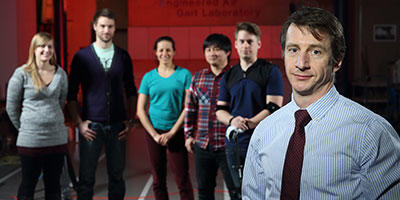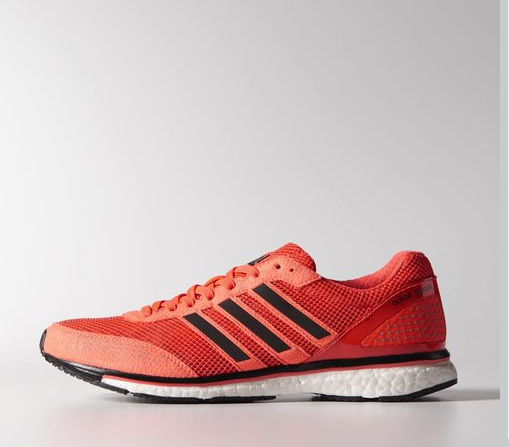
Darren Stefanyshyn, PhD, and members of his lab, in the Human Performance Laboratory.
Oct. 17, 2014

Darren Stefanyshyn, PhD, and members of his lab, in the Human Performance Laboratory.
On Sept. 28 when the eyes of the world were riveted on Dennis Kimetto – the Kenyan marathoner who set a world record marathon time of 2:02:57 in Berlin – the people in Kinesiology’s Human Performance Lab were focused on his shoes.
Kimetto, second-place finisher Emmanuel Muthai, and the top two women — Tirfi Tsegaye and Fayse Tadese — were all wearing the Adidas Adizero Adios BOOST shoe, which was developed in partnership with the University of Calgary’s Faculty of Kinesiology.
“It's always fun and exciting when you've been working on a product to actually see it come to fruition and to see it have an influence on performance,” says Darren Stefanyshyn, a kinesiology researcher who has worked on many Adidas projects over the years including the BOOST.
“We love playing with pieces of equipment that we think could have an influence on injuries or have an influence of performance and when we actually see it in competition and world records being broken … even the small aspect that we play in that gives a lot of satisfaction. That's really what it comes down to,” he says.
Kinesiology’s Human Performance Lab (HPL) is an internationally-renowned, multidisciplinary research hub that provides answers for health and human performance research and helps to develop and test products for many of the world’s top sporting goods manufacturers. In particular, Adidas has developed many of its famous shoes in the HPL, including David Beckham’s Predator soccer shoe and the Adizero Prime sprint shoe worn at the last Olympic Games.

The Adidas BOOST marathon shoe.
Adidas Canada
“We have worked with Adidas on shoe development for many years,” explains Stefanyshyn. “Materials is not really our expertise – that’s more from the Adidas perspective. When it comes to the conceptual, functional, implications of those materials, that's really where we play a role. When we talk to them we say, ‘Hey, can you guys develop some more energy returning materials?’ for example or some softer materials or that sort of thing.
“If we give them the functional requirements of the materials, like the BOOST materials, then they can go out and use their materials, experience, and expertise to be able to develop those materials,” he says.
When working on the marathon shoe Stefanyshyn says they begin with the requirements of marathon running. The shoe has to be ridiculously light, very comfortable, since they have to be worn for two hours, but the cushioning, says Stefanyshyn, shouldn’t sap energy from the runner. “Usually the problems with the compliant, softer materials is they have a lot of damping or hysteresis where they lose a lot of energy,” he says.
“If you can combine a material that is soft and compliant and nice and comfortable, but yet does not have energy loss characteristics or can actually increase the energy return characteristics that's when you have a winner for a marathon shoe. That's exactly where the Boost material comes into play because it's soft and compliant, but yet it doesn't lose all of the energy when the athlete is running in it.”
In the University of Calgary Olympic Oval, there’s a corner that lists the many world records held by the world’s fastest ice, and if the Human Performance Lab continues its streak of record breaking footwear, it might require its own record corner. Stefanyshyn laughs at the thought, then offers, “Having an engineering background, I always like to see products, or I like to see something that I can put on the shelf or put on an athlete that they can use. For me that's a lot more fruitful and a lot more rewarding then just putting a publication out there. Especially when people understand the research and the science behind it.”